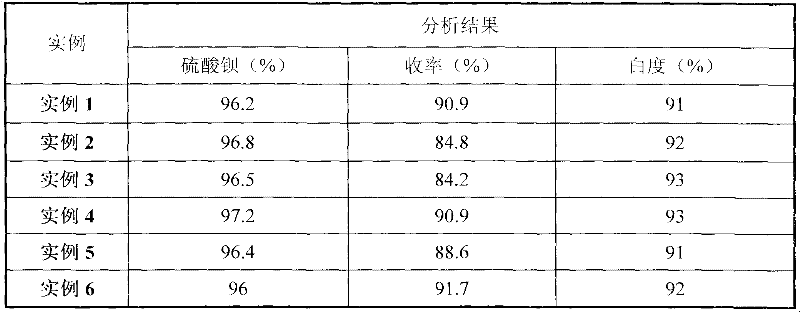Process for producing barium sulfate byproduct in process of removing barium from yellow water
A production process, barium sulfate technology, applied in the direction of calcium/strontium/barium sulfate, calcium carbonate/strontium/barium, etc., can solve the problems of slow natural sedimentation, small barium sulfate particles, pollute the environment, etc., and improve the clarity. , The effect of less input equipment and lower barium ion content
- Summary
- Abstract
- Description
- Claims
- Application Information
AI Technical Summary
Problems solved by technology
Method used
Image
Examples
Embodiment 1
[0018] The production technology of by-product barium sulfate in the barium removal process of embodiment 1 yellow water may further comprise the steps:
[0019] (1) Obtaining yellow water: calcining celestite and reduced coal in a rotary kiln at a temperature of 1000-1250°C to obtain black ash, which is soaked in water to obtain an aqueous solution of strontium sulfide, that is, yellow water; Under the temperature of 80 DEG C, clear yellow water containing 8 g / l of barium ions was obtained after natural sedimentation for 6 hours to remove impurities of acid insolubles and calcium ions.
[0020] (2) Barium removal reaction: take 2m of clear yellow water 3 , and then spray and add 50 l of industrial dilute sulfuric acid with a mass concentration of 10% to carry out the barium removal reaction; continuously stir for 2 hours under the condition of 700r / min at a rotating speed to convert the barium ions into barium sulfate.
[0021] Wherein the equivalent ratio of barium ion to s...
Embodiment 2
[0025] The production technology of by-product barium sulfate in the barium removal process of embodiment 2 yellow water may further comprise the steps:
[0026] (1) Obtaining yellow water: calcining celestite and reduced coal in a rotary kiln at a temperature of 1000-1250°C to obtain black ash, which is soaked in water to obtain an aqueous solution of strontium sulfide, that is, yellow water; The clarified yellow water containing barium ions of 1.4 g / l was obtained after natural sedimentation for 5 hours at a temperature of 85° C. to remove impurities of acid insolubles and calcium ions.
[0027] (2) Barium removal reaction: take 2.4m of clear yellow water 3 , and then spraying and adding 90 l of industrial dilute sulfuric acid with a mass concentration of 2% to carry out the barium removal reaction; continuously stirring for 3 hours at a speed of 400 r / min to convert the barium ions into barium sulfate.
[0028] Wherein the equivalent ratio of barium ion to sulfate radical ...
Embodiment 3
[0032] The production technology of by-product barium sulfate in the barium removal process of embodiment 3 yellow water may further comprise the steps:
[0033] (1) Obtaining yellow water: calcining celestite and reduced coal in a rotary kiln at a temperature of 1000-1250°C to obtain black ash, which is soaked in water to obtain an aqueous solution of strontium sulfide, that is, yellow water; Obtain clear yellow water containing barium ions of 5 g / l after natural sedimentation for 4 hours at a temperature of 80° C. to remove acid-insoluble matter and calcium ion impurities.
[0034] (2) Barium removal reaction: take 2.8m of clear yellow water 3 , then spray and add 400l of industrial dilute sulfuric acid with a mass concentration of 1% to carry out the barium removal reaction; continuously stir for 5 hours under the condition of a rotating speed of 300r / min, so that the barium ions are converted into barium sulfate.
[0035] Wherein the equivalent ratio of barium ion to sulf...
PUM
 Login to View More
Login to View More Abstract
Description
Claims
Application Information
 Login to View More
Login to View More - R&D
- Intellectual Property
- Life Sciences
- Materials
- Tech Scout
- Unparalleled Data Quality
- Higher Quality Content
- 60% Fewer Hallucinations
Browse by: Latest US Patents, China's latest patents, Technical Efficacy Thesaurus, Application Domain, Technology Topic, Popular Technical Reports.
© 2025 PatSnap. All rights reserved.Legal|Privacy policy|Modern Slavery Act Transparency Statement|Sitemap|About US| Contact US: help@patsnap.com

